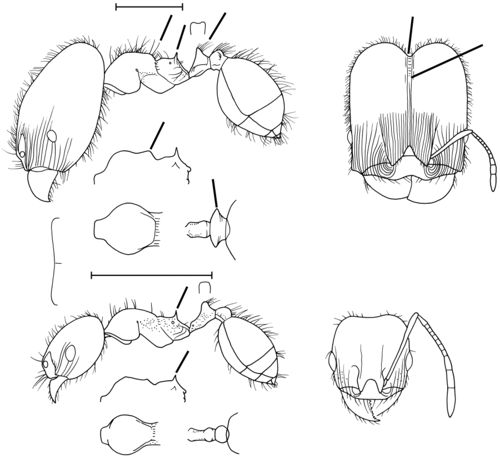Pheidole spadonia
| Pheidole spadonia | |
|---|---|

| |
| Scientific classification | |
| Kingdom: | Animalia |
| Phylum: | Arthropoda |
| Class: | Insecta |
| Order: | Hymenoptera |
| Family: | Formicidae |
| Subfamily: | Myrmicinae |
| Tribe: | Attini |
| Genus: | Pheidole |
| Species: | P. spadonia |
| Binomial name | |
| Pheidole spadonia Wheeler, W.M., 1915 | |
Three colonies were found in a vacant lot in Tucson by Stefan Cover (unpublished field notes), nesting in clayey soil; two had cryptic entrances, and one had a rudimentary crescentic crater of excavated soil. Wheeler’s type series were taken from nests in open sandy soil, the entrances of which were also marked by incomplete craters. The species harvests seeds. (Wilson 2003)
Identification
See the description in the nomenclature section.
Keys including this Species
Distribution
Southern Arizona into Mexico. (Wilson 2003)
Latitudinal Distribution Pattern
Latitudinal Range: 33.60833333° to 25.673212°.
| North Temperate |
North Subtropical |
Tropical | South Subtropical |
South Temperate |
- Source: AntMaps
Distribution based on Regional Taxon Lists
Nearctic Region: United States (type locality).
Neotropical Region: Mexico.
Distribution based on AntMaps
Distribution based on AntWeb specimens
Check data from AntWeb
Countries Occupied
| Number of countries occupied by this species based on AntWiki Regional Taxon Lists. In general, fewer countries occupied indicates a narrower range, while more countries indicates a more widespread species. |

|
Estimated Abundance
| Relative abundance based on number of AntMaps records per species (this species within the purple bar). Fewer records (to the left) indicates a less abundant/encountered species while more records (to the right) indicates more abundant/encountered species. |

|
Biology
According to Wheeler the Tucson colonies were nesting in sand. Those taken by the senior author were nesting in coarse, gravelly soil. The majors of spadonia appear to confine themselves to the nest. The minors forage singly. We were unable to determine what this species eats, but it may be said that at least there was no evidence of harvesting activity. All three of these colonies were small, containing three or four majors and not more than a couple of dozen minors. (Creighton and Gregg 1955)
Castes
Worker
Minor
Images from AntWeb
   
| |
| Worker. Specimen code casent0104753. Photographer April Nobile, uploaded by California Academy of Sciences. | Owned by CAS, San Francisco, CA, USA. |
Nomenclature
The following information is derived from Barry Bolton's Online Catalogue of the Ants of the World.
- spadonia. Pheidole spadonia Wheeler, W.M. 1915b: 400 (s.w.) U.S.A. Creighton & Gregg, 1955: 23 (q.). See also: Wilson, 2003: 600.
Unless otherwise noted the text for the remainder of this section is reported from the publication that includes the original description.
Description
From Wilson (2003): DIAGNOSIS A large reddish yellow (light “orange”) member of the pilifera group.
Major: anterior half of head densely carinulate, with a few carinulae traveling along the dorsal midline all the way to the occiput, and the entire remainder of the body smooth and shiny; propodeal spines well-developed and vertical to the basal propodeal face; the petiolar node seen from the side tapering to a point; the postpetiole seen from above very broad, and spinose.
Minor: propodeal spines well-developed and vertical to basal propodeal face; almost all of the head and mesosoma smooth and shiny.
MEASUREMENTS (mm) Lectotype major: HW 1.72, HL 2.14, SL 0.78, EL 0.22, PW 0.86. Paralectotype minor: HW 0.54, HL 0.60, SL 0.56, EL 0.14, PW 0.38.
COLOR Major: concolorous light reddish yellow (light “orange”).
Minor: concolorous yellow, with a slight reddish tinge on the head.
Figure. Upper: lectotype, major. Lower: paralectotype, minor. Scale bars = 1 mm.
Type Material
ARIZONA: Santa Cruz River, Tucson, col W. M. Wheeler. Museum of Comparative Zoology - as reported in Wilson (2003)
Etymology
L spadonia, impotent, sterile; allusion unknown. (Wilson 2003)
References
- Wilson, E. O. 2003. Pheidole in the New World: A dominant, hyperdiverse ant genus. Harvard University Press, Cambridge, MA.(page 600, fig. major, minor described)
- Creighton, W. S.; Gregg, R. E. 1955. New and little-known species of Pheidole (Hymenoptera: Formicidae) from the southwestern United States and northern Mexico. Univ. Colo. Stud. Ser. Biol. 3: 1-46 (page 23, queen described)
- Csata, E., Dussutour, A. 2019. Nutrient regulation in ants (Hymenoptera: Formicidae): a review. Myrmecological News 29: 111-124 (doi:10.25849/MYRMECOL.NEWS_029:111).
- Wheeler, W. M. 1915b. Some additions to the North American ant-fauna. Bull. Am. Mus. Nat. Hist. 34: 389-421 (page 400, soldier, worker described)
References based on Global Ant Biodiversity Informatics
- Cassill, D.L., J. Butler, S.B. Vinson and D.E. Wheeler. 2005. Cooperation during prey digestion between workers and larvae in the ant, Pheidole spadonia. Insectes Sociaux 52:339-343
- Creighton W. S., and R. E. Gregg. 1955. New and little-known species of Pheidole (Hymenoptera: Formicidae) from the southwestern United States and northern Mexico. University of Colorado Studies. Series in Biology 3: 1-46.
- Dattilo W. et al. 2019. MEXICO ANTS: incidence and abundance along the Nearctic-Neotropical interface. Ecology https://doi.org/10.1002/ecy.2944
- Johnson R. Personnal Database. Accessed on February 5th 2014 at http://www.asu.edu/clas/sirgtools/resources.htm
- Vásquez-Bolaños M. 2011. Lista de especies de hormigas (Hymenoptera: Formicidae) para México. Dugesiana 18: 95-133
- Wilson, E.O. 2003. Pheidole in the New World: A Dominant, Hyperdiverse Genus. Harvard University Press


